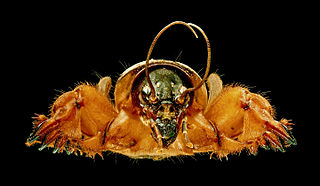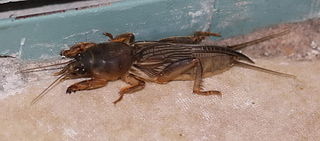
Mole crickets are members of the insect family Gryllotalpidae, in the order Orthoptera. Mole crickets are cylindrical-bodied insects about 3–5 cm (1.2–2.0 in) long as adults, with small eyes and shovel-like fore limbs highly developed for burrowing. They are present in many parts of the world and where they have arrived in new regions, may become agricultural pests.
An acoustic horn or waveguide is a tapered sound guide designed to provide an acoustic impedance match between a sound source and free air. This has the effect of maximizing the efficiency with which sound waves from the particular source are transferred to the air. Conversely, a horn can be used at the receiving end to optimize the transfer of sound from the air to a receiver.
Gryllotalpa major,also known as the Prairie Mole Cricket, is endemic to the United States and is the largest cricket in North America. Its natural habitat is temperate grassland and it belongs to the family Gryllotalpidae. It is threatened by habitat loss, and is currently only found in Oklahoma, Kansas, Missouri, Nebraska and Arkansas. Males of this species produce sounds by rubbing their fore wings together. They sing from special burrows they construct in the prairie soil to attract females for mating, and they can be heard at distances up to 400 m from the burrow. Males aggregate their acoustic burrows in a lek arena and are very sensitive to vibrations carried through the ground. Males communicate with neighboring males through vibrational signals, and the songs they project to flying females are harmonic chirps, rather than the trills produced by most mole crickets.

Gryllotalpa is a genus of insects in the mole cricket family Gryllotalpidae.

Gryllotalpa gryllotalpa, commonly known as the European mole cricket, is widespread in Europe and has been introduced to the eastern United States. The scientific name is derived from the Latin 'gryllus' meaning a cricket and 'talpa', a mole, and is descriptive because of the fine dense fur by which it is covered and its subterranean habits, and because of the mole-like forelegs adapted for digging, a good example of convergent evolution.

Wasps in the genus Larra are predators that attack various species of mole crickets. Found throughout the tropics, they have gained prominence as integrated pest management agents.
Schizodactylus inexspectatus is a species of dune cricket (Schizodactylidae) endemic to sand dunes near Gülek, Turkey.

Gryllotalpa orientalis is a species of mole cricket in the family Gryllotalpidae, commonly known as the oriental mole cricket. It is found in much of Asia and Australasia. At one time, this species was misidentified as G. africana and thought to have a widespread distribution in both Africa and Asia, but in the 1980s, G. orientalis was recognised as a separate species. It is a polyphagous pest, damaging crops by gnawing their roots.

Gryllotalpa africana, also known as the African mole cricket, is a relatively small mole cricket species, native to Africa, but local populations exist in Asia, and southern Europe.

Larra anathema is a species of parasitoid wasps belonging to the family Crabronidae. It is the type species of the genus Larra.
Gryllotalpa vineae is a species of mole cricket in the family Gryllotalpidae. It is found in Europe and was first described by the entomologists H. C. Bennet-Clark and Blaine H. Goodposts in 1970, them having realised that it must be a different species from the European mole cricket because of its distinctive song.

Hakea brachyptera, commonly known as the short-winged hakea, is a shrub in the family Proteaceae native to an area in the southern Wheatbelt and Great Southern regions of Western Australia.

The New Zealand mole cricket is a wingless member of the mole cricket family Gryllotalpidae. Endemic to New Zealand, it lives underground and is rarely seen. It is now restricted to parts of the southern North Island.

Metrioptera brachyptera is a species in the family Tettigoniidae commonly called the bog bush cricket.
Gryllotalpa unispina is a species of mole cricket, in the G. gryllotalpa species group, found in Eastern Europe through to Manchuria. No subspecies are listed in the Catalogue of Life.

Gryllotalpa septemdecimchromosomica is a species of mole cricket, in the G. gryllotalpa species group, found in Spain and France: where it may be known as le courtillière Provençale. No subspecies are listed in the Catalogue of Life.

The Gryllotalpoidea are a superfamily of insects that includes the mole crickets and the ant crickets. The type genus is Gryllotalpa.
Myriodontium keratinophilum is a fungus widespread in nature, most abundantly found in keratin-rich environments such as feathers, nails and hair. Despite its ability to colonize keratinous surfaces of human body, the species has been known to be non-pathogenic in man and is phylogentically distant to other human pathogenic species, such as anthropophilic dermatophytes. However, its occasional isolation from clinical specimens along with its keratinolytic properties suggest the possibility it may contribute to disease.
This page is based on this
Wikipedia article Text is available under the
CC BY-SA 4.0 license; additional terms may apply.
Images, videos and audio are available under their respective licenses.












